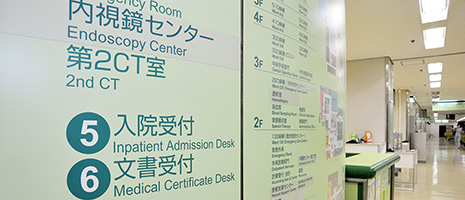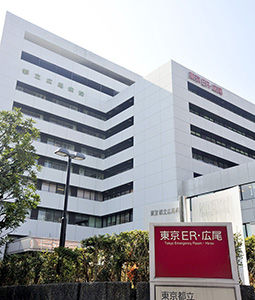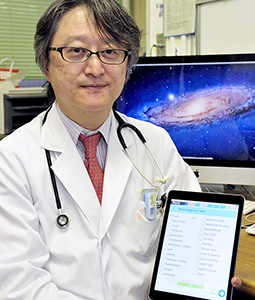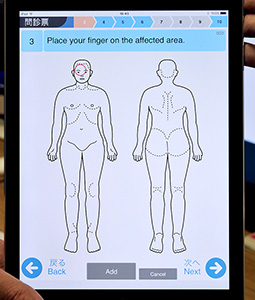Home > Highlighting JAPAN > Highlighting Japan March 2017 > Living and Working in Japan
Highlighting JAPAN

Equal Treatment
At Tokyo Metropolitan Hiroo Hospital, systems are in place to ensure that international patients have access to the institution’s advanced medical services in much the same way as Japanese patients do.
Efforts are currently underway in Tokyo to accredit the medical institutions that will provide athletes and others with medical services during the 2020 Tokyo Olympics and Paralympics as Olympic Partner Hospitals in response to a request from the International Olympics Committee (IOC). Around ten general hospitals equipped with cutting-edge health care facilities near the Olympic Village or the Olympic Stadium will be selected as partner hospitals.
Tokyo Metropolitan Hiroo Hospital is one of the hospitals that are expected to play a significant role as partner medical institutions for the 2020 Tokyo Olympics and Paralympics. It serves as a flagship hospital, providing emergency medical care, disaster medicine and island community medical services. Located in Shibuya Ward where large numbers of foreigners choose to live, Hiroo Hospital has treated many international patients. More than 350 patients from more than fifty countries visited the hospital during the four months from October 2016.
Hiroo Hospital has taken a range of steps to facilitate communications with international patients. Most signs and floor maps are written in both Japanese and English, and some are written in Chinese and Korean as well. The hospital was listed as a Medical Institution Capable of Accepting Foreign Tourists1 on the website of the Japan National Tourism Organization in March 2016 and as a Regional Base Hospital Accepting International Patients by the Ministry of Health, Labour and Welfare in July 2016.
“We are making every possible effort to upgrade our capability to deal with foreign patients,” says Yasuko Nishiyama, the manager of the hospital’s Planning Department. “We launched foreign-language training programs for all our employees three years ago and offer related training opportunities including workshops, seminars, and learning through DVDs. We remain firmly committed to offering medical services seamlessly to international patients visiting our hospital, and that is the strength of our hospital.”
In April 2016, the hospital hired four interpreters for patients who speak English or Chinese, as well as a nurse specializing in medical coordination for international patients.
“International patients visiting us for the first time usually feel uneasy because of the language problems they anticipate,” says Mayumi Okauchi, the nurse specializing in medical coordination for international patients. “My job is to help international patients who are in need of language assistance by explaining the diagnosis and treatment to them. It is more important than anything else for us to ensure that a non-Japanese speaking patient understands his or her condition while being treated at the hospital. Our Patient Support Center, a cross-functional organization of the hospital that seeks to support international patients regardless of their nationalities, is one of the key features of our hospital.”
Twelve years ago the Department of Pediatrics at Hiroo Hospital launched an online medical questionnaire system in English for international patients. At the request of the Tokyo Metropolitan Government, Dr. Yasuhito Yamamoto, the Department’s General Manager and Director of Management Planning, has further developed the system for international patients and made it compatible for use with tablet PCs.
“The system is designed to eliminate misunderstandings when a doctor provides medical treatment to a non-Japanese speaking patient. The Tokyo Metropolitan Government is currently looking to establish a cutting-edge platform that will facilitate the extensive use of tablet PCs in medical services. In this regard as well, the development of the medical questionnaire system is important,” says Dr. Yamamoto.
To begin the process, the patient is asked to tick the relevant symptoms listed on the screen of the tablet PC in response to the question, “What brought you here?” As the patient continues identifying his or her symptoms on the screen, related questions appear automatically, including a request to indicate the affected area by touching the relevant part of the human body diagram on the screen. While the system is currently limited to use by English-speaking patients only, it will be further developed as a multilingual system in the future. The latest upgrade of the system, which includes systematic linkage with electronic medical charts, is currently undergoing testing.
“Every one of us working in the hospital shares a desire to ensure that international patients have access to the medical services provided by our hospital in much the same way as Japanese patients do. It appears that we have finished establishing a basic platform for this. Going forward, we will remain focused on activities for making further improvements to the system,” says Okauchi. “We will remain committed to working together with the aim of becoming a hospital selected by all patients, regardless of nationality.
© 2009 Cabinet Office, Government of Japan









